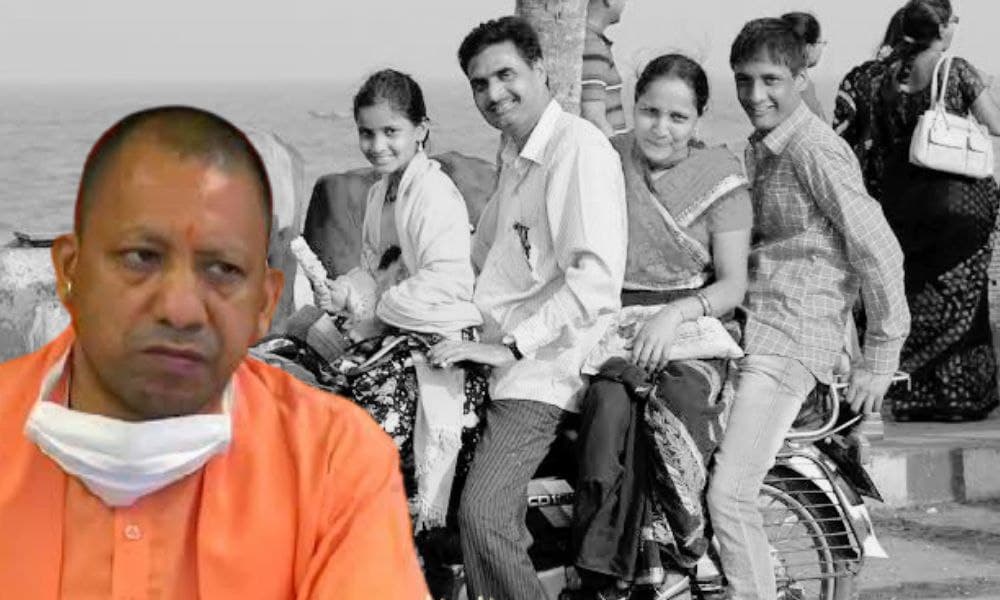Uttar Pradesh Unveils New Population Policy, Aims To Bring Population Growth To 2.1%
Writer: Anuran Sadhu
A post grad journalism student of SIMC, Pune with a passion for using words to get my message across in the most unique ways possible and curiosity is the force that drives me to learn and experience more every day.
Uttar Pradesh, 11 July 2021 2:10 PM GMT
Editor : Madhusree Goswami |
A mountain girl trying to make it big in the city. She loves to travel and explore and hence keen on doing on-ground stories. Giving the crux of the matter through her editing skills is her way to pay back the journalism its due credit.
Creatives : Anuran Sadhu
A post grad journalism student of SIMC, Pune with a passion for using words to get my message across in the most unique ways possible and curiosity is the force that drives me to learn and experience more every day.
The draft bill proposes that people with more than two children will be barred from contesting local bodies polls, applying for government jobs or receiving any kind of subsidy
On World Population Day, July 11, Uttar Pradesh Chief Minister Yogi Aditanath released the state's new population policy. The chief minister said that population control is the need of the hour and the government wants to bring down the birth rate to 2.1 by 2026. A draft bill on population control has been uploaded on the state law commission website, and suggestions will be invited till 19 July. It is prepared by the Uttar Pradesh Health Department and based on the findings of the National Family Health Survey-4 (NFHS-4).
What Does The Draft Bill Propose?
The draft bill proposes that people with more than two children will be barred from contesting local bodies polls, applying for government jobs or receiving any kind of subsidy. It also bars government employees from getting a promotion.
"Public servants who adopt the two-child norm will get two additional increments during the entire service, maternity or as the case may be, paternity leave of 12 months, with full salary and allowances and three percent increase in the employer's contribution fund under the National Pension Scheme," according to government's draft population control bill. Those not employed by the government and still adhering to the policy will get benefits in in rebates in taxes on water, housing, home loans etc. Further, if the parent of a child opts for vasectomy, he/she will be eligible for free medical facilities till the age of 20.
The state has a population of around 220 million.
Call for a community-centric approach
Chief Minister Yogi Adityanath said that poverty and illiteracy are the two significant factors in population expansion. He added that there is a lack of awareness about the population in some communities and therefore called for a community-centric approach to control the population.
According to a government spokesperson, the proposed policy will follow a five-pronged approach to control the population, but the policy will be focused on improving health. The policy will also make efforts to provide solutions for impotency or infertility and bring down women and newborns' mortality rates. It is also likely to offer better management, health and nutrition to adolescents between 11 and 19 years, besides making arrangements to take care of the elderly, reported Times of India. The policy will also look for strategies to converge existing schemes and streamline population control efforts and improve health.
In The Spirit Of SDGs
The new policy should make efforts to maintain demographic balance in all communities. It should also ensure the availability of health facilities and bring down maternal and child mortality rates through proper nutrition, the Chief Minister said. He also said that the objective of the new policy should be embedded in the spirit of the Sustainable Development Goals.
Targets Set In Two Phases
While the new Population Policy draft is being prepared after studying NFHS-4, the NFHS-5 is also scheduled to be released soon. Therefore, the targets of the new policy will be set in two phases, 2026 and 2030. Among others, the government plans to set up a state population fund to implement the measures. The draft bill also asks the state government to introduce population control as compulsory subject in all secondary schools.
Apart from Uttar Pradesh, Assam is also pushing for a similar policy. Last week, Chief Minister Himanta Biswa Sarma said that population norms will be slowly implemented for government schemes.
Also Read: Assam Proposes Two-Child Policy To Avail Govt Schemes
 All section
All section















